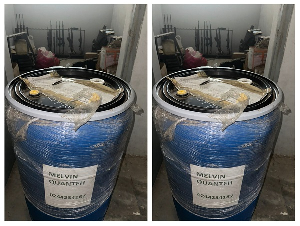Business News of Tuesday, 27 May 2003
Source: gna
Non-traditional exports jumps 10%%
Receipts from non-traditional exports have reached an all-time record of $504.3 million. The breakthrough came after four years of stagnant export earnings, which stood at an average of $416 million between 1988 and 2001, a GEPC report on the sub-sector has revealed.
This represents 9.7 per cent increase over the previous year's figure of $459.6 million. A total of 3,083 firms and individuals exported 257 different items as compared to 3,117 that exported 260 items in 2001.
According to a report on the Export Performance of the Non-Traditional Export Sector published by the GEPC made avialable to Daily Graphic B&F it said the manufacturing sector recorded the highest revenue of $407.2 million, representing a
12.3 per cent increase over the previous year's figure of $362.727 million.
This is followed by the agricultural sector, which contributed $85.7 million, followed by the handicrafts sector, which recorded $11.3 million, a drop from $14.9 million recorded in 2001.
Cocoa cake, liquor and butter were the highest earners, raking in $81.9 million, an increase of 24.7 per cent over the 2001 figure of $65.7 million.
According to the report the country exported non-traditional commodities to 115 destinations world-wide, during the 2002 export year.
The European Union had 59.6 per cent of the total volume of exports. Major European countries such as the United Kingdom imported 17.2 per cent; France, 11.9 per cent; The Netherlands, 7.6 per cent; Italy, 6.6 per cent; Germany, 5.6 per cent; Spain, 5.2 per cent and Belgium 4.1 per cent.
The report revealed that leading exports to these destinations were mainly wood products, horticultural products, canned tuna, cocoa butter, cake and liquor.
Other developed countries took a total of 11.2 per cent of the exports. They included the United States of America, 8.3 per cent; Switzerland, 0.91 per cent and Sweden, 0.7 per cent.
According to the report, the ECOWAS market accounted for 24.31 per cent of Ghana’s total non-traditional exports, with Nigeria taking 7.7 per cent; Togo, 6.2 per cent; Cote d’ d’Ivoire, 3.4 per cent; Burkina Faso, 2.4 per cent and Benin, 1.98 per cent.
The main products to the ECOWAS market were frozen tuna, edible salt, aluminium utensils, plywood, cigarettes, cotton fabrics, hair products, ammonium nitrate and articles of plastic.
Non-traditional export to other Africa countries was 1.5 per cent out of which 0.81 went to South Africa with imports such as plywood, raw cotton, processed tobacco and veneer.
Other countries took 3.4 per cent with products such as cocoa liquor, frozen tuna and builders woodwork. The list was dominated by India with 1.12 per cent of imports from Ghana.
On the performance of sub-sectors, the report disclosed that the agricultural sub-sector saw an increase of 4.57 per cent from $81.8 million in 2001 to $85.7 million.
A total of 1,442 exporter, exported 78 agricultural products in 2002, as compared to 1,570 exporters, who exported 75 products in 2001.
The major contributors to this sector were horticultural products, fresh pineapples, fresh yams, bananas, fish and seafood. The rest are maize, medicinal plants and cola nuts.
Foreign exchange earnings from the handicraft sub-sector plummeted from $14.8 million in 2001 to $11.3 million. This was due to a reduction in straw baskets, which recorded $555,000 as compared to $4.766 million in 2001.
The report indicated that aluminium products, cocoa cake, liquor and butter, aluminium plates, sheets and coils, and prepared foods and beverages were among the major contributors to manufacturing sector.
Other products under this sector include builder woodwork, articles of plastic, cotton fabrics, Ammonium nitrate, sheabutter, peeled pineapple and processed natural rubber.










